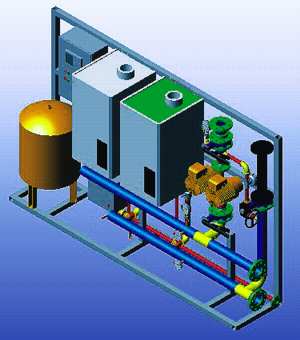Enjoying the benefits of prefabrication
Designers, contractors and end users should make much more use of prefabricated boiler and hot-water plant, says Ken Percival.Much talk has been going on in the construction industry over the last decade relating to finding ways of building faster, cheaper and better-quality buildings — particularly in the commercial sector as clients’ demands and requirements have continued to grow. With design-and-build projects becoming more commonplace, more consultants are looking at the ideal scenario for modern construction — a ‘total building prefabrication approach.’ As no building is complete without heating and hot water, this approach represents a major change in the way these systems have traditionally been specified and designed. Challenge For contractors and specifiers, the adoption of a prefabricated approach to heating and hot water is therefore something new and, like most new concepts, represents a challenge to traditional thinking, which will inevitably receive a mixed and cautious response from its audience. This, however, should not be the case as prefabrication ‘does exactly what is says on the tin.’ For example, prefabrication can provide a total black-box solution that incorporates both heating and hot water — combining boilers with hot water storage or water heaters to offer a total slot-in solution, which is fully commissioned and simply requires a home and attachment to gas and water supplies. It is not just the benefits offered by such a black-box solution for heating and hot water that dictates the move to prefabrication, it is the overall cost of a project and the time allocated to each part of the construction or building refurbishment works. Full advantage To take full advantage of the prefabricatedapproach to providing heating and hot water, designers and consultants need to consider the space and system requirements at the earliest stages. This is especially important when designing the building’s heating system, identifying load requirements and hot-water usage, as these elements are key to standardising the requirements of a prefabricated system. At this stage it is often beneficial to talk to the experts by seeking technical advice from a manufacturer. In our experience at, once customers contact our technical helpline for advice and guidance, they can to identify time and cost saving opportunities through adopting pre-designed and proven prefabricated solutions. As a manufacturer, we have recognised the potential for prefabricated solutions and invested time and expertise in designing, testing, installing and commissioning a variety of different projects over a number of years. It is this expertise that we actively encourage designers, specifiers and contractors to tap into, particularly those who are new to the concept. Best way From a manufacturer’s viewpoint, prefabrication is the best way of ensuring customers get systems that are suited to their needs and designed to operate at maximum efficiency. From our perspective, no one understands our products better than our own design, service and commissioning engineers. Given the requirements of a project, these individuals are able to achieve ultimate black-box heating and hot water performance by matching hot-water storage with water heaters, boilers with controls, fluing, pumps, tanks and other components needed to provide heating and hot water for a building.
Delivering plant for heating and generating domestic hot water to site prefabricated relieves congestion and concurrent working from site.
commercial@pottertoncommercialco.uk







